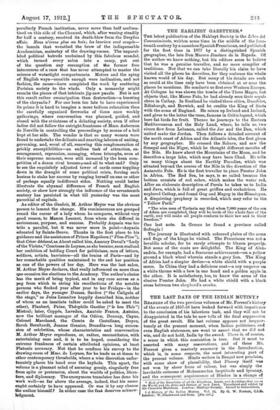THE EARLIEST GAZETTEER.*
TEE latest publication of the Hakluyt Society is the Libre del Conoschniento, written some time in the middle of the four- teenth century by a nameless Spanish Franciscan, and published for the first time in 1877 by a distinguished Spanish
geographer, the late Don Marcos Jimenez de la Espada. Of the author we know nothing, but his editors seem to believe that he was a genuine traveller, and no mere compiler of traditions. Not that we can take literally his claim to have visited all the places he describes, for they embrace the whole known world of his day. But many of his details are such as could at the time only have been obtained at or near the places he mentions. He conducts us first over Western Europe. At Cologne he was shown the torahs of the Three Mages, but objects that, like Marco Polo, he had already seen their sepul- chres in Cathay. In Scotland he visited three cities, Dumfries, Edinburgh, and Berwick, and he credits the King of Scots with the arms of England. He mixes up Ireland and Iceland, and gives to the latter the trees, famous in Celtic legend, which bore fat birds for fruit. Thence he journeys to the Eastern Mediterranean and the Holy Land, where, be tells us, two rivers flow from Lebanon, called the Jor and the Dan, which united make the Jordan. Then follows a detailed account of the north coast of Africa and the Atlantic isles, the first given by any geographer. He crossed the Sahara, and saw the Senegal and the Niger, which he thought different mouths of the Nile. He knew about the Mountains of the Moon, and he describes a large lake, which may have been Chad. He tells us many things about the Earthly Paradise, which was situated beyond the source of the Nile in the direction of the Antarctic Pole. He is the first traveller to place Prester John in Africa. The Red Sea, he says, is so called because the bottom consists of red ochre, which makes the water red.
After an elaborate description of Persia he takes us to India and Java, which is full of great griffins and cockatrices. He explored Cathay, and found Gog and Magog in the Himalayas.
A disquieting .prophecy is recorded, which may refer to the "'Yellow Peril."
"The wise men of Tartaria say that when 7,000 years of the era of Adam are completed, they will be lords of the whole face of the earth, and will make all people conform to their law and to their freedom."
One last note. In Greece he found a province called Sufragia !
The journey is illustrated with coloured plates of the arms and flags of the kings he visited. The Franciscan was not a
heraldic scholar, for he rarely attempts to blazon properly. But some of the coats are delightful. The King of Alex.
andria, for example, had a fearsome achievement—on a yellow ground a black wheel wherein stands a grey lion. The King of Africa had a simpler device—a white shield with a purple moon. In China they had a delicious coat—a coy emperor on a white throne with a bow in one hand and a golden apple in the other. It is satisfactory, too, to know the arms of the elusive Prester John. He had a white shield with a black cross between two shepherd's crooks.






































 Previous page
Previous page